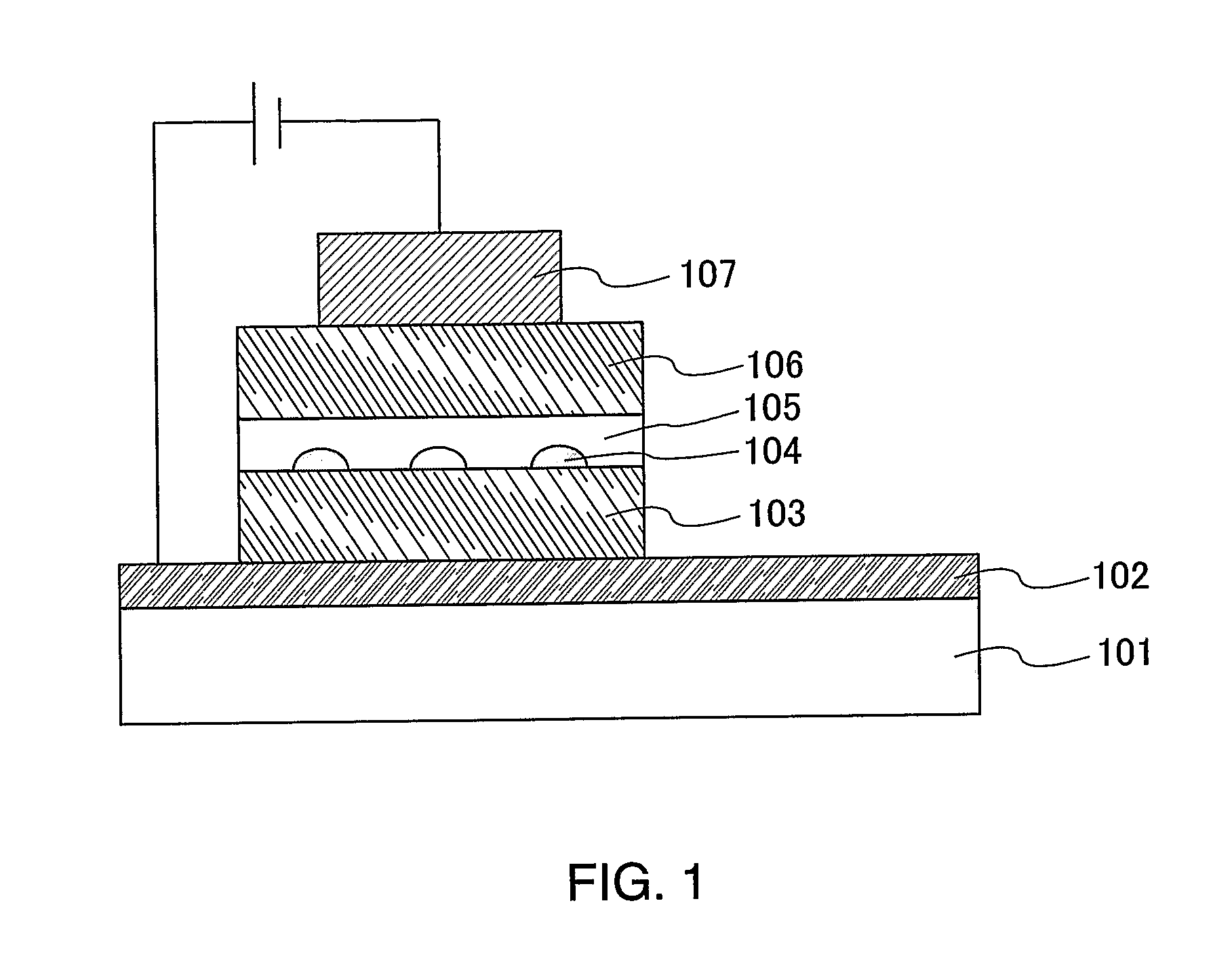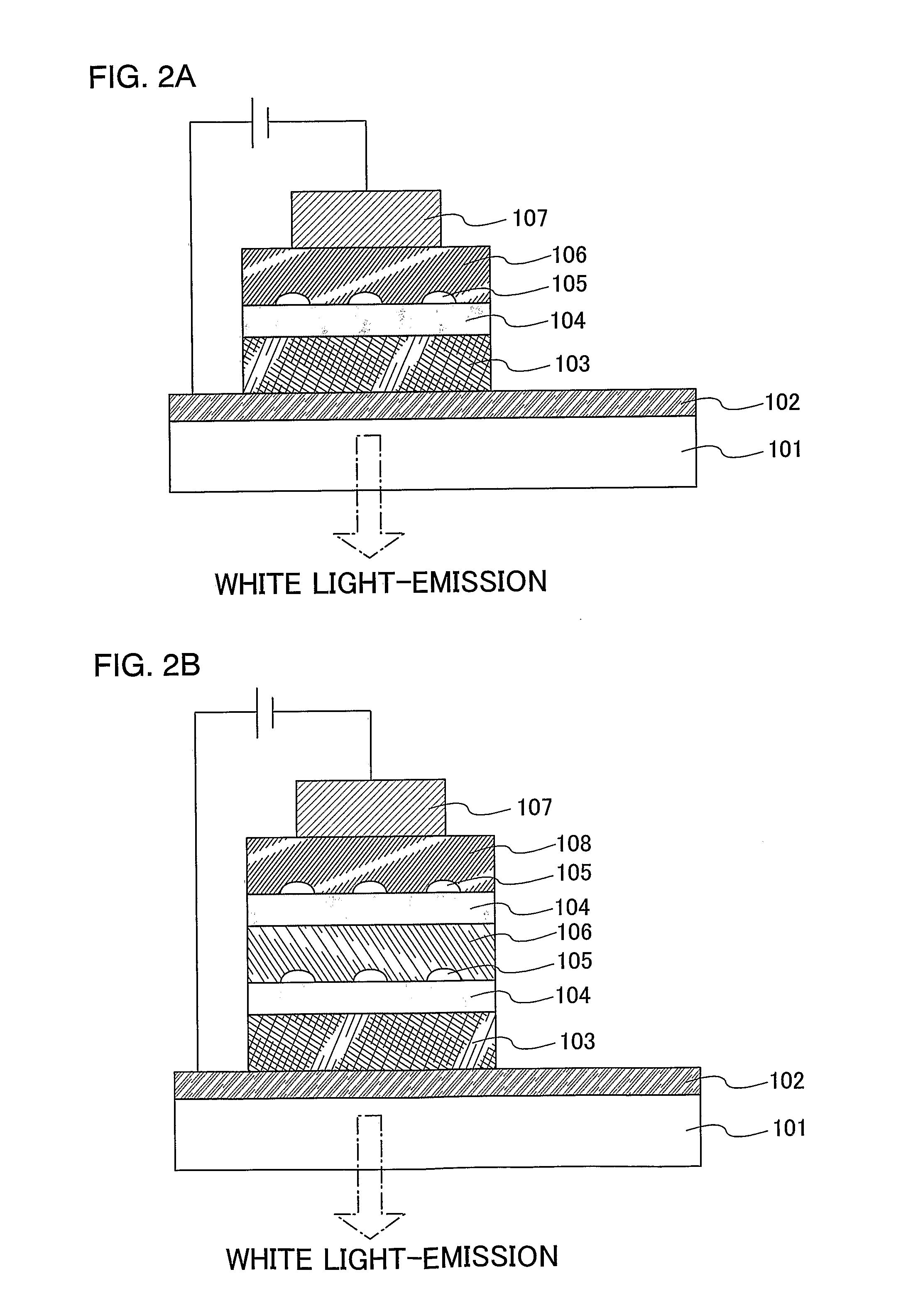Light-Emitting Element and Display Device
a technology of light-emitting elements and display devices, which is applied in the direction of discharge tubes/lamp details, discharge tubes luminescnet screens, electric discharge lamps, etc., can solve the problems of reducing the manufacturing process of elements, reducing the actual use of materials, and reducing so as to reduce the cost, reduce the manufacturing time of elements, and achieve high light-extraction efficiency
- Summary
- Abstract
- Description
- Claims
- Application Information
AI Technical Summary
Benefits of technology
Problems solved by technology
Method used
Image
Examples
example 1
[0059] In this example, the structure of an active matrix display device (also referred to as an active matrix light-emitting device) using a light-emitting element according to Embodiment is explained with reference to FIGS. 3A, 3B4A and 4B. A display device according to this example has a plurality of pixels 310 including a plurality of elements in a region formed by the intersection of a source line Sx (x is a natural number, 1≦x≦m) with a gate line Gy (y is a natural number, 1≦x≦n) with an insulator interposed therebetween (FIG. 3A). The pixel 310 has a light-emitting element 313, a capacitor element 316 and two transistors. One of the two transistors is a transistor for switching 311 (switching transistor) for controlling input of a video signal to the pixel 310, and the other is a transistor for driving 312 (driving transistor) for controlling light emission and non-light emission of the light-emitting element 313. The capacitor element 316 serves to hold gate-source voltage o...
example 2
[0092] In this example, an example of a pixel circuit that can be applied to the present invention except the pixel circuit shown in FIG. 3A is explained with reference to FIGS. 5A and 5B. FIG. 5A shows a pixel circuit having a structure in which a transistor 340 for erasing and a gate wiring Ry for erasing are added to the pixel 310 that is shown in FIG. 3A. Since current does not flow to the light-emitting element 313 forcibly by the arrangement of the transistor 340, a lightning period can be started simultaneously with or immediately after starting a writing period without waiting for writing signals into all of pixels 310. Therefore, a duty ratio is improved, and thus a moving image can be especially displayed so well.
[0093]FIG. 5B shows a pixel circuit in which a transistor 312 of the pixel 310 shown in FIG. 3A is omitted and transistors 341, 342, and a power source line Vax (x is a natural number, 1≦x≦1) are provided anew. The power source line Vax is connected to a power so...
example 3
[0094] In this example, stacked layer structures of the wiring 414 (including a second power source 318 through this example) and the pixel electrode (anode or cathode) in the foregoing example are explained with reference to FIGS. 6A to 6D. FIGS. 6A to 6D each show only a part of a light-emitting element of a pixel region. In the FIGS. 6A to 6D, a second light-emitting layer, an intermediate conductive layer and the like are not shown.
[0095]FIG. 6A shows the case that the wiring is formed to have a stacked layer structure of Mo 600 and an alloy containing aluminum 601 and the pixel electrode (e.g., anode 102 through this example) is formed using ITO 602. As the alloy containing aluminum 601, aluminum containing carbon, nickel, cobalt, iron, silicon, or the like is preferably used. It is preferable that the rate of content of carbon is preferably 0.1 to 3.0 atomic %; at least one kind of nickel, cobalt, and iron, 0.5 to 7.0 atomic %; and silicon, 0.5 to 2.0 atomic %. The material h...
PUM
 Login to View More
Login to View More Abstract
Description
Claims
Application Information
 Login to View More
Login to View More - R&D
- Intellectual Property
- Life Sciences
- Materials
- Tech Scout
- Unparalleled Data Quality
- Higher Quality Content
- 60% Fewer Hallucinations
Browse by: Latest US Patents, China's latest patents, Technical Efficacy Thesaurus, Application Domain, Technology Topic, Popular Technical Reports.
© 2025 PatSnap. All rights reserved.Legal|Privacy policy|Modern Slavery Act Transparency Statement|Sitemap|About US| Contact US: help@patsnap.com



